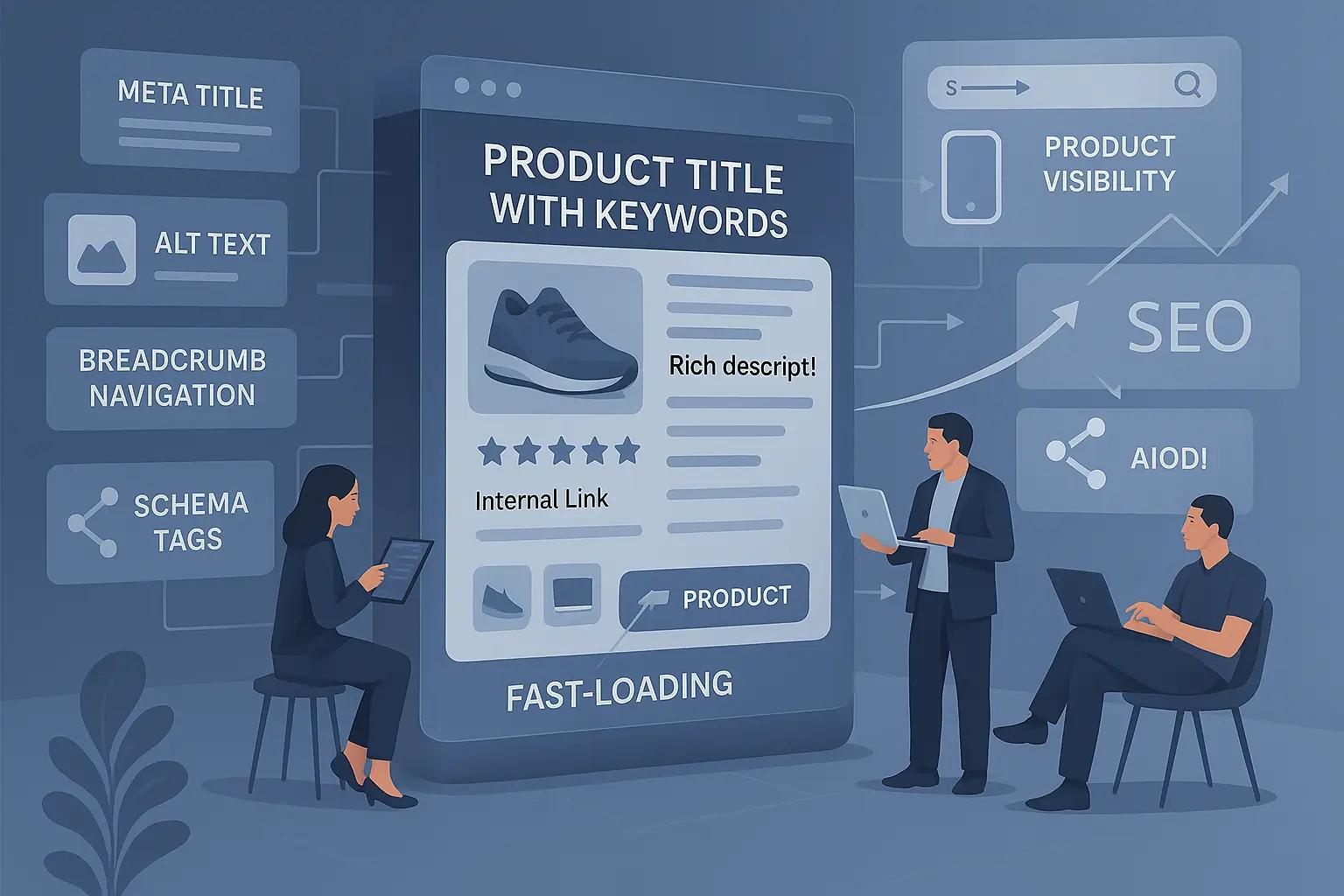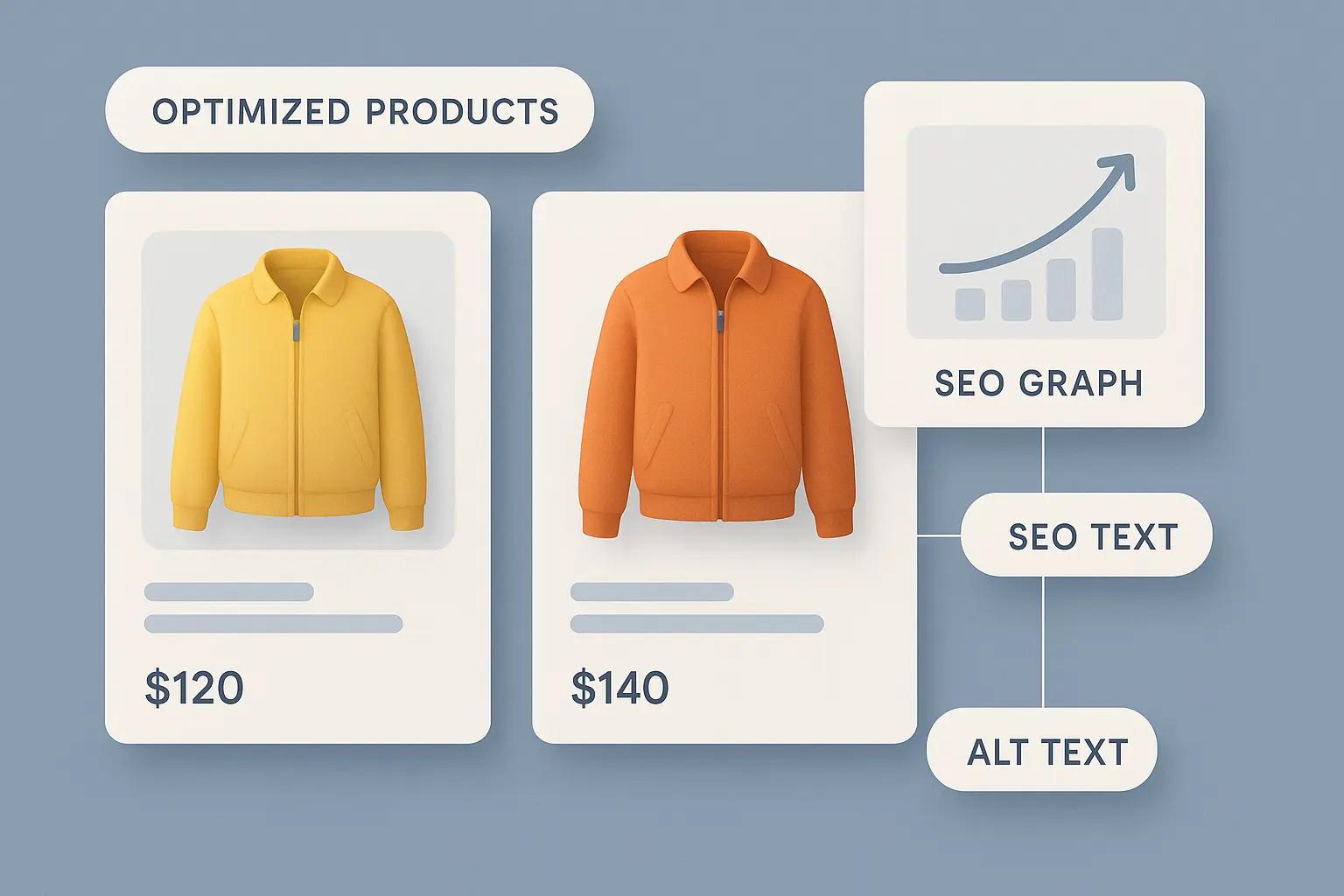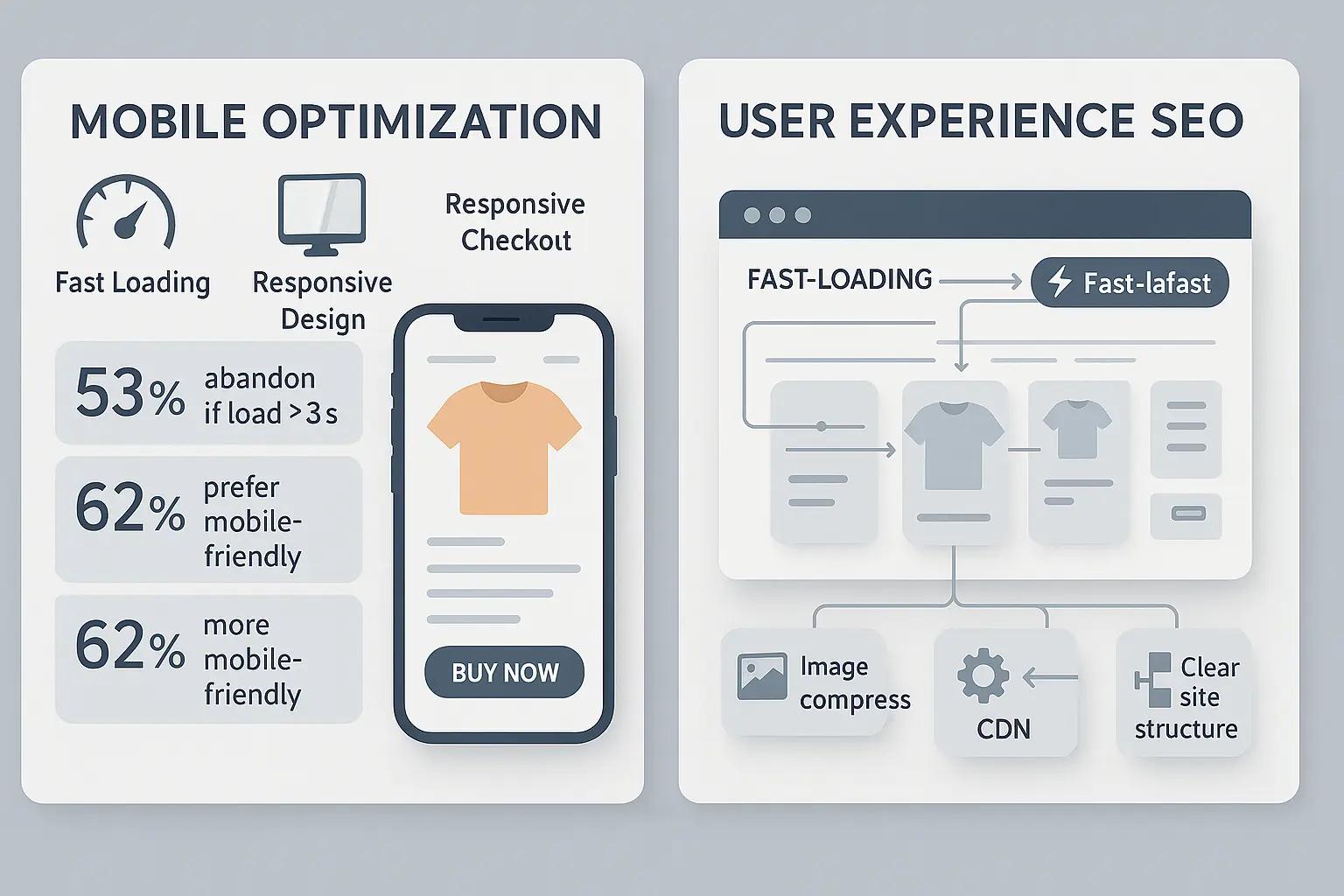
In the world of digital retail, knowing how to use e-commerce SEO is key. Making your product pages better is a top strategy for businesses. Search engines like pages that are easy to use and full of useful info.
Good e-commerce SEO is more than just using the right keywords. It's about making your site both good for search engines and easy for users. This means thinking carefully about everything from product descriptions to technical details.
Optimizing product pages is a big job that needs careful planning. You need to make content that search engines like and that will grab the attention of buyers. Your product pages should be full of useful info and clearly show what makes your products special.
Key Takeaways
- Understand the critical role of SEO in e-commerce success
- Develop comprehensive product page optimization strategies
- Balance technical SEO with user-centered content
- Create informative and engaging product descriptions
- Prioritize user experience alongside search engine requirements
Understanding the Fundamentals of E-commerce SEO
E-commerce website optimization is key for online stores wanting to be seen more online. It's not just about using the right keywords. It's about a detailed plan for digital marketing.
Good ecommerce on-page SEO needs many parts working together. This boosts search rankings and makes the site better for users.
Core Elements of Product Page Optimization
Optimizing product pages means focusing on a few important things:
- High-quality, unique product descriptions
- Clear, descriptive product titles
- Professional product images with optimized alt text
- Structured product data markup
Why Product Pages Matter for Search Rankings
"Your product pages are the most valuable real estate in your e-commerce ecosystem." - Digital Marketing Experts
Search engines see product pages as key signs of a site's value and trustworthiness. When these pages are well-optimized, it tells search engines you have quality content. This can help your site rank better overall.
Key Performance Metrics for E-commerce Pages
| Metric | Importance | Ideal Range |
|---|---|---|
| Page Load Speed | User Experience | Under 3 seconds |
| Bounce Rate | Engagement | Less than 50% |
| Conversion Rate | Sales Performance | 2-5% |
Knowing these metrics helps e-commerce sites improve their on-page optimization. This can lead to better search engine visibility
Creating SEO-Friendly Product Page URLs and Site Structure
Building a strong ecommerce site architecture is key for better search engine rankings and user experience. A well-organized site structure is the backbone of successful ecommerce technical SEO. It helps both search engines and customers find their way through your online store.
Making SEO-friendly URLs needs careful planning. Your product page URLs should be clear and follow your site's structure. Here are some important tips:
- Use descriptive, keyword-rich URL paths
- Keep URLs concise and easy to read
- Implement a clean, hierarchical structure
- Avoid unnecessary parameters or complex strings
"Clean, structured URLs are like a roadmap for search engines and users alike." - SEO Expert
The best ecommerce site structure is like a pyramid:
- Homepage
- Category pages
- Subcategory pages
- Individual product pages
Internal linking is vital in your site structure. Strategic internal links help distribute page authority. They also help search engines understand your site's page relationships. Create a network of pages that makes it easy for users to explore your products.
By using these ecommerce technical SEO strategies, you'll build a site architecture that search engines and customers will love.
Mastering Product Page Meta Tags and Descriptions
Meta tags are key players in your e-commerce strategy. They help search engines and customers understand your products. Knowing how to write good meta tags can boost your site's visibility and clicks.
Keyword research is the base of effective meta tags. These HTML elements give search engines vital info about your product pages.
Writing Compelling Meta Titles
Meta titles grab user attention first. Make them:
- Short (50-60 characters)
- Clear about the product
- Include main keywords
- Unique for each page
"A great meta title is like a mini-advertisement for your product" - SEO Experts
Crafting Click-Worthy Meta Descriptions
Meta descriptions are your product's quick pitch in search results. They should:
- Sum up product features
- Highlight what makes it special
- Include a call-to-action
- Stay under 150-160 characters
Implementing Custom Meta Tags for E-commerce
E-commerce sites can use special tags for more context. Think about adding:
- Product pricing tags
- Availability indicators
- Brand info
- Review schema markup
By focusing on your meta tags, you build a strong SEO base. This attracts search engines and potential customers.
Optimizing Product Images for Search Engines
Image optimization is key for better search engine results. It makes your website more attractive to customers and boosts your ranking. Visual content is a strong tool for drawing in and keeping potential buyers.

Implementing Custom Meta Tags for E-commerce
E-commerce sites can use special tags for more context. Think about adding:
- Product pricing tags
- Availability indicators
- Brand info
- Review schema markup
By focusing on your meta tags, you build a strong SEO base. This attracts search engines and potential customers.
Optimizing Product Images for Search Engines
Image optimization is key for better search engine results. It makes your website more attractive to customers and boosts your ranking. Visual content is a strong tool for drawing in and keeping potential buyers.
Don't use generic names like "IMG_001.jpg" for your images. Instead, choose names that include important keywords. For example, "blue-leather-mens-wallet.jpg" tells both users and search engines what the image is about.
"Great images are not just visual content – they're strategic SEO assets." - Digital Marketing Expert
Keeping your images small is important for your website's speed. Big images can slow down your site, hurting both user experience and your search rankings.
| Image Optimization Technique | SEO Impact |
|---|---|
| Descriptive File Names | Improved Keyword Relevance |
| Alt Text | Enhanced Accessibility |
| Image Compression | Faster Page Load Speed |
By using these image optimization tips, e-commerce sites can make their visual content more friendly to search engines. This can lead to more organic traffic and better site performance.
Crafting Compelling Product Descriptions That Convert
E-commerce product descriptions are like silent salespeople for your online store. They are key in making your content better and boosting sales. They help attract customers and seal the deal.
Good product descriptions do more than list features. They turn ordinary details into stories that meet customer needs and wants.
Writing Unique Value Propositions
A strong value proposition can make your product shine in a busy market. Think about these important points:
- Focus on how your product solves problems
- Point out what makes your product special
- Use emotional triggers that connect with your audience
Incorporating Long-tail Keywords Naturally
Keyword research is vital for making your product descriptions easy to find. The trick is to add long-tail keywords smoothly without making it hard to read.
"Great product descriptions sell the experience, not just the product." - Ecommerce Marketing Expert
Balancing SEO with User Intent
Your main goal is to write descriptions that please both search engines and buyers. You need to make content that answers questions and is still engaging.
- Deal with customer concerns
- Give clear, simple info
- Use a friendly yet professional tone
By getting good at these strategies, you'll make product descriptions that rank well and really speak to your audience. This will help boost sales.
E-commerce SEO, Product Page Optimization, SEO for E-commerce: Best Practices
Mastering e-commerce SEO means using a smart plan for product page optimization. Today's online stores need to use many strategies to be noticed in the digital world.
Advanced keyword research targeting specific product niches
- Creating unique, compelling product descriptions
- Optimizing page load speeds
- Implementing structured data markup
"Great SEO isn't about gaming the system, it's about creating remarkable user experiences" - Rand Fishkin
For ecommerce SEO to work, it needs to keep getting better. Search engines look for sites that offer real value and focus on the user.
| SEO Strategy | Impact Level | Implementation Difficulty |
|---|---|---|
| Mobile Responsiveness | High | Medium |
| Rich Product Descriptions | High | Low |
| Schema Markup | Medium | High |
Using these product page optimization methods can greatly help e-commerce sites. They can improve their visibility in search engines and keep users interested.
Implementing Schema Markup for Product Pages
Schema markup is key in ecommerce technical SEO. It helps search engines get your product page content. This makes your site more visible in search results.
Product schema markup gives search engines all the details about your products. This leads to rich snippets. These snippets can make people more likely to click on your site.
Essential Schema Types for E-commerce
There are a few important schema types for product pages:
- Product Schema: Tells about product details
- Offer Schema: Shows pricing info
- AggregateRating Schema: Shows customer ratings
- Review Schema: Shares what customers say
Technical Implementation Guidelines
Adding schema markup needs focus on technical SEO. JSON-LD is the best way to add it to your site's HTML. It's easy to use.
| Schema Type | Key Properties | SEO Impact |
|---|---|---|
| Product Schema | Name, Image, Description | High Visibility |
| Offer Schema | Price, Availability | Enhanced Search Results |
| Review Schema | Rating, Author | Trust Signals |
Testing and Validation Methods
It's important to check your schema markup. Google has tools like the Structured Data Testing Tool. They help make sure your markup is right.
"Proper schema markup can transform your product pages from basic listings to rich, information-packed search results." - SEO Expert
Learning about product schema markup can boost your ecommerce site's SEO. This leads to more visibility and engagement.
Mobile Optimization Strategies for Product Pages

Mobile optimization is key for ecommerce sites today. Over 70% of online shopping is done on mobiles. So, making mobile shopping smooth is crucial.
For mobile optimization, you need a detailed plan. It should cover several areas of your online store. Important steps include:
- Using responsive design that fits all screen sizes
- Keeping pages fast for mobile users
- Making navigation and checkout easy
- Optimizing images and videos for mobile
"Mobile optimization is not just about making your site look good on smaller screens—it's about creating an intuitive, fast, and enjoyable shopping experience." - Ecommerce Design Expert
Here are some key metrics showing why mobile optimization matters:
| Mobile Performance Metric | Impact on Conversion |
|---|---|
| Page Load Speed | 53% of mobile users abandon sites taking over 3 seconds to load |
| Responsive Design | 62% more likely to purchase from mobile-friendly websites |
| Touch-Friendly Interface | Increases engagement by 40% |
Google favors mobile-friendly sites in search rankings. Accelerated Mobile Pages (AMP) can help make your site load super fast. This boosts your mobile optimization.
By focusing on mobile, ecommerce sites can better user experience, boost sales, and rank higher in search engines.
Enhancing User Experience for Better SEO Performance
Creating a great user experience is key for boosting conversions and search rankings in ecommerce SEO. Online shoppers want easy, smooth interactions. They want their shopping journey to be fun and hassle-free.
Successful ecommerce sites know that user experience is linked to conversion rates. By focusing on important areas, brands can improve their online image and customer happiness.
Page Load Speed Optimization
Website speed is vital for user experience and search rankings. Slow sites annoy customers and lead to more people leaving. To speed up your site, consider these steps:
- Compress and optimize product images
- Minimize CSS and JavaScript files
- Leverage browser caching mechanisms
- Use content delivery networks (CDNs)
Navigation and Internal Linking
Good navigation makes it easy for users to find what they need. It also helps search engines crawl your site better. Here are some tips for better navigation:
Make your site structure clear and logical
Use breadcrumb navigation
Link related products together
Use descriptive anchor texts
Customer Review Integration
Customer reviews add trust and valuable content. They help improve both user trust and SEO. Here's how to make the most of reviews:
| Review Strategy | SEO Impact |
|---|---|
| Visible review sections | Increases content relevance |
| Structured review schema | Improves rich snippet potential |
| Encouraging verified reviews | Builds credibility |
"Great user experience transforms casual browsers into loyal customers." - Ecommerce UX Expert
By focusing on these user experience areas, ecommerce sites can become engaging and search-friendly. This drives more traffic and boosts conversions.
Content Strategy for Product Category Pages
Product category pages are key in your ecommerce content plan. They act as guides, helping customers find what they need. They also help your site show up better in search results.
To make category pages work well, you need a solid plan for keywords and on-page optimization. Your aim is to make content that meets what users are looking for.
- Do deep keyword research to find search terms for categories
- Write unique, detailed content for each category page
- Use long-tail keywords in page descriptions
- Link related categories together
"Great category pages transform navigation from a functional task into an engaging discovery experience."
Good on-page optimization mixes useful text with clear product displays. Add short, interesting category descriptions. They should give context and answer questions customers might have.
Use content from users like reviews and ratings to boost your category page's authority. Strategic content development turns category pages into powerful tools for sales.
Technical SEO Considerations for E-commerce Sites
Understanding ecommerce technical SEO is key. It involves site structure and search engine optimization. These technical aspects greatly affect your online store's visibility and performance.
- Server response times and page load speed
- Secure HTTPS implementation
- Handling product variants without creating duplicate content
- XML sitemap management
- International SEO strategies
"A well-optimized technical infrastructure is the backbone of successful e-commerce search engine performance." - SEO Experts
Performance metrics are vital for checking your site's health. Strong site structure and technical optimization boost your e-commerce site's search engine visibility. Always monitor and improve to keep your technical SEO at its best.
Conclusion
Mastering e-commerce SEO is more than just simple tactics. It's about making your product pages better to attract more visitors. By using the strategies from this guide, online stores can boost their search engine rankings.
The world of e-commerce SEO is always changing. Search engines update their rules, and how people use the internet changes too. To stay ahead, online stores need to keep improving their sites and SEO skills.
The best e-commerce SEO strategy combines technical skills with a great user experience. Search engines like websites that are easy to use and offer valuable content. By focusing on making your product pages useful and easy to navigate, you can improve your rankings and sales.
SEO is a continuous effort, not a one-time job. Spend time learning about your customers, using data to guide your decisions, and keeping up with new marketing trends. With dedication and smart planning, your e-commerce site can grow and succeed in a competitive online world.

Custom video production at scale
Aneeverse covers all video needs whether you're telling your brand story, launching a product or running ads. Discover how we can help you scale.
